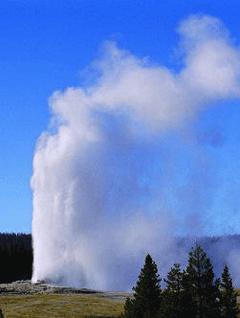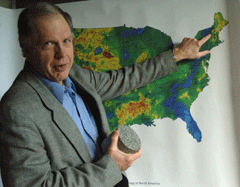Deep Heat
Air Date: Week of February 2, 2007

Old Faithful Geyser in Yellowstone National Park (Courtesy of the U.S. Department of Energy)
A report by the Massachusetts Institute of Technology says the United States should invest money in tapping energy from deep in the ground. Curt Nickisch reports on the promise of a new geothermal technology process called heat mining.
Transcript
CURWOOD: Dig down a few feet into the soil here in North America and you’ll find a zone of earth that’s roughly 55 degrees Fahrenheit all the time. It’s a source of heat from the earth that is practically inexhaustible. If you dig down a lot deeper, the earth gets a lot warmer, and in some places you can even find steam, at temperatures of hundreds of degrees. In the next few weeks we’ll report on a major building project that’s tapping so-called geothermal energy just below the surface. But right now we turn our attention to a new study of geothermal resources by the Massachusetts Institute of Technology. It says we could find almost unlimited geothermal energy by digging much deeper into the hot rocks down below, using a new technique called “deep heat mining.” Curt Nickisch of member station WBUR has our report.
NICKISCH: Einstein once said he had little patience for scientists who drill a hole where the drilling’s easy. It was a metaphor of course. But in a basement lab at MIT, Chad Augustine is quite literally drilling a hole where it’s very, very hard: through a slab of granite. And he’s doing so with a pointed blue flame, that’s making the grey stone snap crackle and pop.
It’s uncanny to watch the rock flake under the flame. In about thirty seconds, the torch bores a hole into the rock one inch deep. Augustine wants to repeat this down into the earth, inch by inch, to reach hot water cooking miles below the surface. To do that today with conventional drilling, the cost is in the millions - exponential the deeper you go. Augustine says that’s because drill bits constantly wear out. To replace them, it means bringing up miles of tubing.
AUGUSTINE: So you pull up thirty feet, unscrew it, set it aside. Pull up thirty feet, unscrew it, set it aside. With this though, since the drill it’s just a flame, it never actually comes in contact with the surface, you could theoretically drill forever.
NICKISCH: You wouldn’t need to drill that far. Get about six miles under most of Massachusetts, for instance, and you reach water hot enough to drive a steam turbine to generate electricity.
AUGUSTINE: Like in a place like Boston that doesn’t have a high heat gradient in the Earth, you need a really deep hole to get water at temperatures of 200 or 300 degrees Celsius. Which is really high quality steam – you can use it to make a good geothermal energy plant. And our hope is that with a system like this where you don’t have to stop and take drill pipe out constantly and put it back in, you can get there cheaper and faster.
NICKISCH: And sooner rather than later, hopes MIT chemical engineering professor Jeff Tester. He’s compiled a new report on geothermal energy – the most comprehensive on the resource in decades. It’s a call to arms to invest in this sort of deep heat mining, which is relatively clean. Tester says the payoff could be huge.
TESTER: This is a large resource. Essentially so large that it could be viewed as being sustainable for as long as we’d need it. So it’s not like we’re going to just find a few pockets of hot rock and that will be the end of it in a few years, this could really be viewed as a sustainable resource for the long term.

MIT Professor Jefferson W. Tester (Photo: Donna Coveney/MIT)
THORSTEINSSON: So everyone has geothermal district heating, and when I was little I thought that was the only way you could heat houses. And then when I went abroad, I was like: oh, oh no, you don’t have the great resource that we have. So it’s part of just how the country developed, what path you took.
NICKISCH: A new path for the U.S. is mapped out in the MIT study. It calls for up to eight hundred million dollars of investment and research into deep heat mining over the next ten years. That’s when it projects the industry would become competitive on the market - and that fifty years from now, the U-S would get a tenth of its energy from geothermal.
But getting funding from Congress is a hard sell, says Curt Robinson. He runs the non-profit Geothermal Resources Council. He says part of the problem is that America’s geothermal energy plants – mainly in the West - are out of sight, out of mind.

Old Faithful Geyser in Yellowstone National Park (Courtesy of the U.S. Department of Energy)
ROBINSON: It’s largely an invisible form of energy. If there are wind turbines out, one sees the blades spinning and they think: okay, that’s creating power. If one sees solar panels, they see that and think conceivably one’s drawing energy from the sun. Geothermal activity has largely been very regional and very rural.
NICKISCH: That’s mainly because the industry set up plants with the best access to geothermal resources. Jeff Tester at MIT hopes rising demand for renewable energy brings deep heat mining front and center.
TESTER: The opportunity is real. America is particularly well-blessed with geothermal. This would be an enormous asset to our long-term energy security, and I think in a very sustainable fashion.
NICKISCH: Whether more parts of the country are home to geothermal energy plants mining heat miles below the earth’s surface, may depend on whether Tester and others like him can drill their point into the minds of policymakers.
For Living on Earth, I’m Curt Nickisch.
Links
MIT Energy Research Council: "Underground Heat: an omnipresent source of electricity
Living on Earth wants to hear from you!
Living on Earth
62 Calef Highway, Suite 212
Lee, NH 03861
Telephone: 617-287-4121
E-mail: comments@loe.org
Newsletter [Click here]
Donate to Living on Earth!
Living on Earth is an independent media program and relies entirely on contributions from listeners and institutions supporting public service. Please donate now to preserve an independent environmental voice.
NewsletterLiving on Earth offers a weekly delivery of the show's rundown to your mailbox. Sign up for our newsletter today!
 Sailors For The Sea: Be the change you want to sea.
Sailors For The Sea: Be the change you want to sea.
 The Grantham Foundation for the Protection of the Environment: Committed to protecting and improving the health of the global environment.
The Grantham Foundation for the Protection of the Environment: Committed to protecting and improving the health of the global environment.
 Contribute to Living on Earth and receive, as our gift to you, an archival print of one of Mark Seth Lender's extraordinary wildlife photographs. Follow the link to see Mark's current collection of photographs.
Contribute to Living on Earth and receive, as our gift to you, an archival print of one of Mark Seth Lender's extraordinary wildlife photographs. Follow the link to see Mark's current collection of photographs.
 Buy a signed copy of Mark Seth Lender's book Smeagull the Seagull & support Living on Earth
Buy a signed copy of Mark Seth Lender's book Smeagull the Seagull & support Living on Earth

